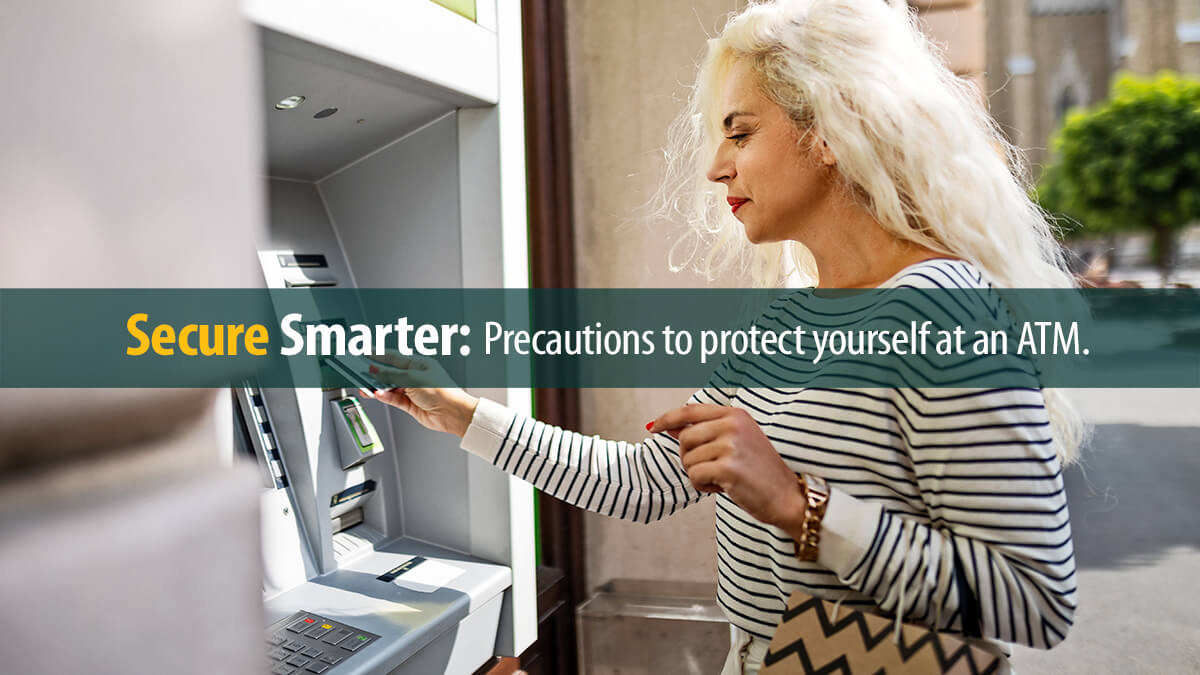Knowledge Is The First Line Of Defense
When it comes to the security of your financial transactions, all avenues are important. Two that often get overshadowed by online security are debit cards and ATMs.
There are a few best practices to consider when using your debit card or an ATM. You can think of them collectively as “The Five-S Plan”:

1. Secure Your Information
-
It may seem more convenient to leave your debit card on your desk at work or in the glove box of your car, but anytime it’s not with you, it’s susceptible to falling into the wrong hands.
-
Security experts recommend never writing down your PIN (personal identification number) or using personal information like birthdays, social security numbers, or house numbers.
-
It’s easy to panic when you lose your debit card but try to remember that your financial institution doesn’t want you to lose money either. So whenever you can't find your card, reach out to your credit union or bank right away. At First Source, you can block your card immediately and unblock it once you find it. This can be done by contacting First Source directly or through online banking.
-
In general, it’s good practice to avoid giving out your debit or credit card information over the phone unless you're sure you're speaking directly to your financial institution. If you are being pressured to provide private information keep the following in mind:
-
There is some information that is public: name, address, phone number, and even email. But full SS#, online account login credentials, PINs, and full card numbers are not public information and should NEVER be shared via phone call or text.
-
From time to time, you may be asked to reset your own password or re-PIN a card, but First Source will NEVER ask you to disclose it or give it to us. Only thieves will ask for this information.
2. Select The Right ATM
-
Your best bet is to use an ATM operated by your financial institution at a location familiar to you. If this isn't an option, try to choose a machine in a well-lit area not obscured by trees, bushes, or other objects that could be used by a thief to hide behind.
-
At night, make sure that the ATM you choose to use is lit up. First Source ATMs are monitored 24/7 and in well-lighted areas.
-
It's wise to scan the area around the ATM when you arrive. If someone is lurking nearby and doesn't seem to have a particular purpose for being there, it might be in your best interest to find a different ATM.
3. Safeguard Yourself At The Machine
-
Try to make ATM transactions with a family member or friend when possible. Criminals are less likely to target someone who's got a partner looking out for them.
-
If you're using a drive-up ATM, keep your doors locked, windows rolled up, and the engine running.
-
If you’re at a walk-up machine and someone is standing closer than you’d like while you’re using the ATM, cancel your transaction and find another machine to use. They might be trying to spy on your PIN.
-
It’s natural to want to count your money after making a withdrawal but doing so can give a crook an idea of how much money you took out while providing them extra time to approach you. It’s best to move on quickly and count your money when you’re in a more comfortable location.
-
Take your receipt with you. While that little piece of paper doesn’t have all your personal information, it does contain bits of data fraudsters can use to steal your identity.
4. Stay Vigilant
-
After you’ve withdrawn money, survey the area around you again. If someone is following you, head to the nearest place with people in or around it. As soon as you're close to other people, take out your phone and call the police.
-
It’s a good idea to regularly monitor your online or paper statements for fraudulent transactions. Contact your financial institution if something doesn’t look right.
5. Spot Skimming Scams
Skimmers are devices criminals attach to ATMs and other card-reading terminals to harvest sensitive information and fraudulently access accounts. Your best method for fighting this sinister tactic is to use your financial institution’s ATMs and also stay on the lookout for these crude electronic overlays. If you see an ATM that matches these descriptions, report it to the machine’s owner and find another ATM to use.
-
Loose plastic casing
-
Misaligned pieces
-
Sticky residue or tape
-
Stiff buttons
-
Wobbly keypad
-
Cracked or damaged housing
-
Oversized card slot
-
Oddly colored plastic around the card slot
-
Unusual on-screen instructions
Knowledge is always the first line of defense. Feel good about knowing you’ve taken the necessary precautions to secure yourself and your information.
Live Smarter
If you feel you may be a target of a scam or would like more information about how to better protect yourself, please contact First Source at 315-735-8571 to report any activity that might seem suspicious to our Member Care Center. You can also visit our Identity Protection page to learn additional ways to keep your information and accounts safe.
Bring This Session to a Live Setting
If you would like to schedule our Community Educator for a seminar or workshop for any Financial Friday educational topic, please email your request to FinancialEducation@fsource.org
This article has been adapted from Balance Pro in partnership with First Source FCU.